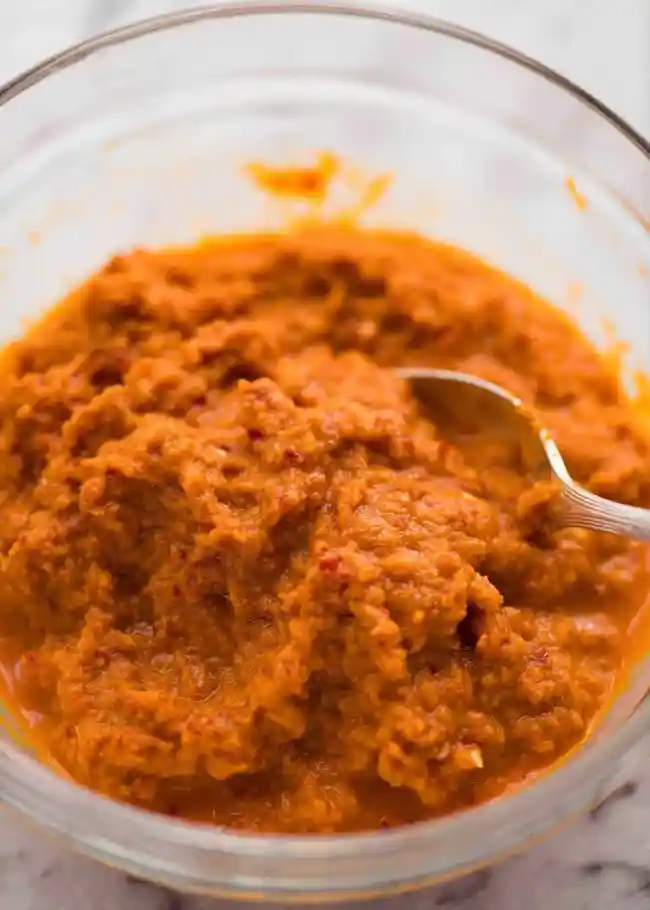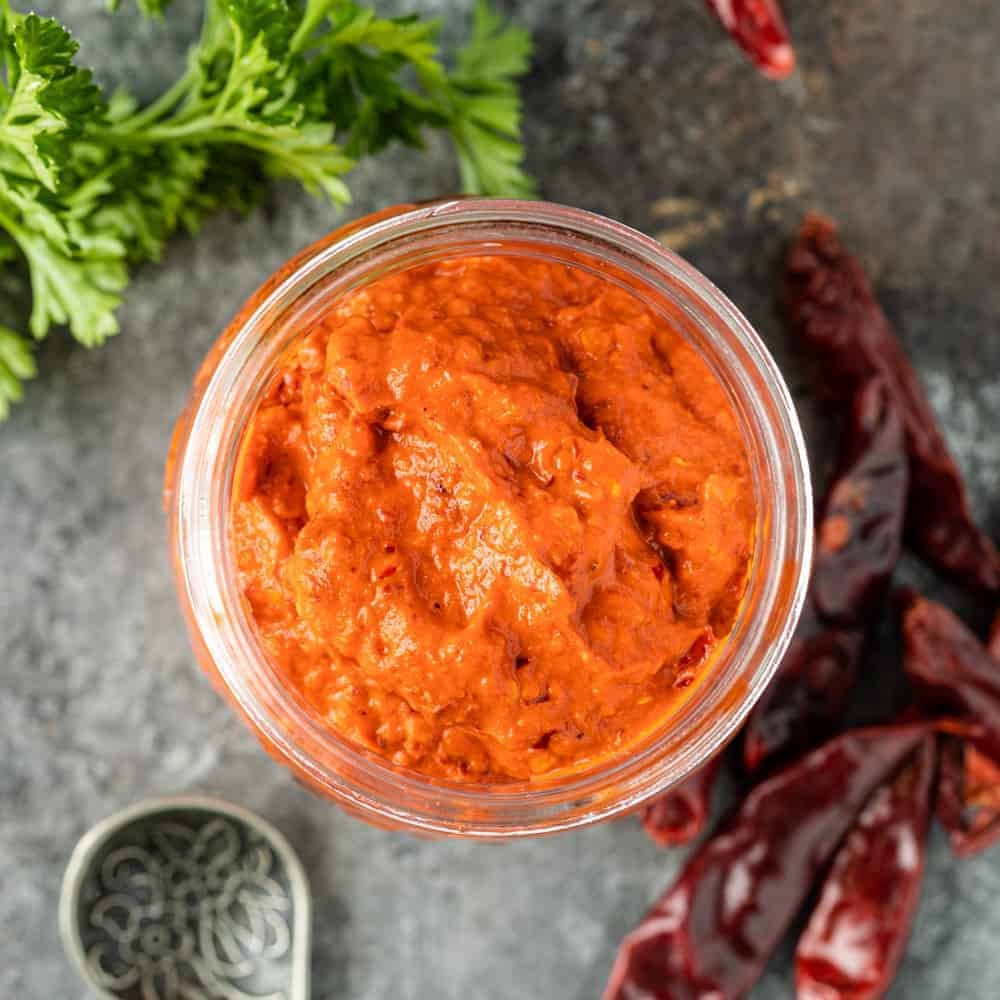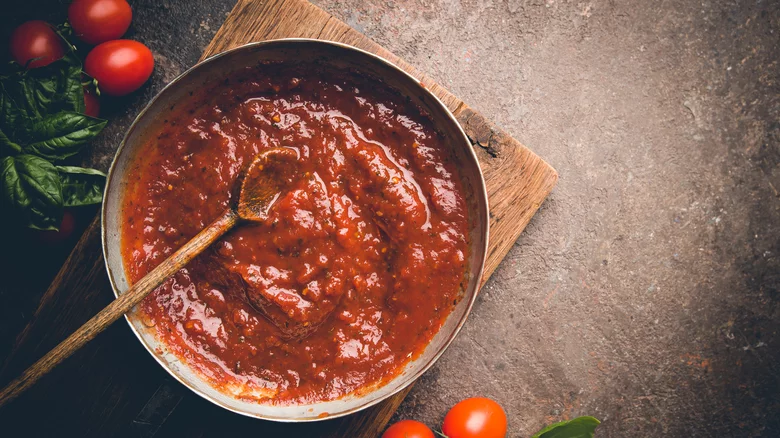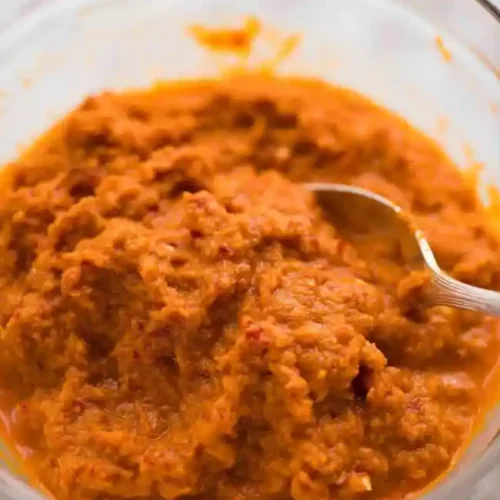We’ve all been there.
It’s dinnertime, you’re on the verge of starting a delicious recipe when you realize you don’t have red curry paste in your pantry.
What do you do?
Before resigning yourself to ordering takeout, give these 8 suggestions for substitutes for red curry paste a try!
A good substitute for red curry paste should add bold flavor and Asian-style zest to your dish without taking too long to prepare it or adding ingredients that are hard to find.
Each one listed here will help give those dishes the Thai taste we’re aiming for – and if none of them quite hits the spot, turn up the heat with some chili powder or fresh chilies instead!
Your substitution for red curry paste will depend much on what is available in your local store, as well as what other flavors may complement your particular dish.
If access to ethnic foods stores like an Asian grocer aren’t viable options nearby, rest assured that there are plenty of common goods from which you can bootstrap a decent rough approximation – even sans specialty items.
So let’s get started!
Here is my guide to finding delectable substitutes for red curry paste so that no matter where life takes us (or whatever limits our grocery store visits may bring), we’ll be able to enjoy Southeast Asian cuisine at home.
What is Red Curry Paste?

Red curry paste is a spicy, flavorful condiment used in Thai cooking.
It is made from a blend of aromatic ingredients such as red chilies, garlic, shallots, lemongrass, galangal (Thai ginger), kaffir lime leaves, and spices like cumin and coriander.
The ingredients are ground together to form a thick paste that can be used to make curries or other dishes.
Red curry paste has a deep red color due to the high concentration of dried red chilies in the mix.
It has an intense flavor with notes of sweetness from the shallots and lemongrass, earthiness from the spices and heat from the chilies.
Red curry paste can be found in most Asian grocery stores or online retailers.
When using red curry paste for cooking it should be added at the beginning of preparation so that its flavors have time to infuse into other ingredients like coconut milk or vegetables.
Depending on how much heat you prefer you can add more or less than what is called for in recipes; however keep in mind that too much will overpower other flavors so start small and adjust accordingly!
The 8 Best Substitutes For Red Curry Paste
Red curry paste is an essential ingredient in Thai cooking, but it can be hard to find.
If you’re looking for a substitute, here are eight alternatives that will still give you the same flavor and texture:
1 – Curry Powder

Curry powder is a blend of spices originating from India.
It is used to flavor many dishes, including curries, stews, and soups.
Curry powder typically contains turmeric, cumin, coriander, ginger, fenugreek, cardamom and chili pepper.
Curry powder has a warm and earthy taste with hints of sweetness from the cinnamon and cloves.
It can be used as a dry rub for meats or vegetables before roasting or grilling; it also works well in marinades or sauces for added depth of flavor.
Pro Tip: To make your own curry powder at home you can mix together equal parts ground coriander seed, ground cumin seed, ground turmeric root and ground black pepper. You can also add other spices like cardamom pods or dried chilies to customize the flavor profile!
2 – Yellow Curry Paste
https://www.pinterest.com/pin/5699937019257604/Yellow curry paste is made from yellow curry powder combined with other ingredients such as lemongrass, galangal (Thai ginger), kaffir lime leaves, shallots and garlic.
The result is a fragrant paste that has a milder flavor than red curry paste but still packs plenty of flavor!
Pro Tip: Yellow curry paste can also be used to make Thai-style soups like Tom Kha Gai (chicken coconut soup) or Tom Yum Goong (shrimp soup). Just add the paste to your broth along with some vegetables and protein for an easy meal!
3 – Green Curry Paste
https://www.pinterest.com/pin/67554063154033625/Green curry paste is a type of Thai curry paste made from green chilies, garlic, lemongrass, galangal (Thai ginger), kaffir lime leaves, and other spices.
It is used to make the popular Thai dish known as Green Curry.
Green curry paste has a unique flavor that can be described as spicy, sweet and sour all at once.
The combination of herbs and spices creates an intense flavor that is both complex and delicious.
It’s also incredibly versatile; it can be used in stir-fries, soups, curries or even marinades for meat or fish dishes.
Pro Tip: If you’re looking for a milder version of green curry paste, try adding some coconut milk or cream to your dish to balance out the heat!
4 – Sambal Oelek

Sambal Oelek is a spicy Indonesian condiment made from ground red chilies, vinegar and salt.
It is used as a condiment or an ingredient in many dishes such as curries, soups, stir-fries and marinades.
Sambal Oelek has a bright red color and a spicy flavor that can range from mild to hot depending on the type of chili pepper used.
Sambal Oelek is often used as an alternative to red curry paste because it has similar flavors but without the added sweetness that comes with the paste.
The heat level of Sambal Oelek can be adjusted by adding more or less chili peppers to the mix.
Pro Tip: To make your own Sambal Oelek at home, simply blend together equal parts fresh red chilies (seeds removed), garlic cloves, shallots, ginger root and lime juice until smooth. Add some sugar if desired for sweetness and adjust the heat level by adding more or less chili peppers!
5 – Harissa Paste

Harissa paste is a spicy condiment made from chili peppers, garlic, olive oil and spices.
It originates from North Africa and is popular in Middle Eastern cuisine.
Harissa paste can be used as a marinade for meats or vegetables, added to soups or stews, spread on sandwiches or mixed with yogurt for a dip.
Harissa paste has a complex flavor profile that combines the heat of chili peppers with the sweetness of garlic and other spices like cumin, coriander and caraway seeds.
The heat level varies depending on the type of pepper used but it generally ranges from mild to very hot.
Pro Tip: To reduce the spiciness of harissa paste without sacrificing its flavor, add some tomato puree or diced tomatoes when cooking with it. This will help mellow out the heat while still providing plenty of flavor!
6 – Chili powder

Chili powder is a blend of ground chili peppers and other spices.
It’s commonly used in Mexican, Indian, and Asian cuisines to add flavor and heat to dishes.
Chili powder can range from mild to very spicy depending on the type of chilies used.
Chili powder has a deep red color with earthy, smoky notes that come from the combination of dried chilies, garlic, cumin, oregano, coriander and other spices.
It adds an intense flavor to any dish without being too overpowering or hot.
Pro Tip: To reduce the spiciness of chili powder when cooking with it, try adding some sugar or honey to balance out the heat!
7 – Chili paste

Chili paste is a condiment made from ground chilies, garlic, and other spices.
It is commonly used in Asian cooking to add flavor and heat to dishes.
Chili paste can be found in many forms including sambal oelek (a type of Indonesian chili sauce), gochujang (Korean chili paste), and harissa (Tunisian chili paste).
Chili paste has a bold flavor that adds depth and complexity to any dish. It’s great for adding heat without overpowering the other flavors in the dish.
Try it as a marinade for meats or vegetables, or use it as a base for soups or stews.
You can also mix it with mayonnaise or yogurt to make an easy dipping sauce!
8 – Tomato paste with chili flakes

Tomato paste with chili flakes is a combination of tomato paste and chili flakes.
The tomato paste adds a rich, sweet flavor to the dish while the chili flakes add a spicy kick.
This combination is perfect for adding depth and complexity to dishes like curries, stews, sauces, soups, and more.
Tomato paste with chili flakes can be used as a substitute for red curry paste in many recipes.
It’s easy to make at home by combining equal parts tomato paste and chili flakes (or more or less depending on your desired level of heat).
You can also purchase pre-made versions from most grocery stores.
Pro Tip: To reduce the spiciness of this mixture, try adding some sugar or honey to balance out the flavors.
Conclusion
In conclusion, red curry paste is a flavorful and aromatic addition to many dishes.
However, if you don’t have red curry paste on hand, there are several other ingredients that can be used as a good substitute.
The best substitutes for red curry paste are curry powder, yellow curry paste, green curry paste, sambal oelek, harissa paste, chili powder, chili paste, and tomato paste with chili flakes.
Each of these ingredients has its own unique flavor and can be used to create a variety of dishes.
Using a combination of these ingredients is a great way to add flavor and complexity to your dish, and will ensure that you never have to go without red curry paste again.

The 8 Best Substitutes For Red Curry Paste
Ingredients
- Curry Powder
- Yellow Curry Paste
- Green Curry Paste
- Sambal Oelek
- Harissa Paste
- Chili powder
- Chili paste
- Tomato paste with chili flakes
Instructions
- Pick your favorite substitute from the list above.
- Follow cooking directions for your selected substitute with the proper ratio of ingredients.
Jenny has always been passionate about cooking, and she uses her platform to share her joy of food with others. Her recipes are easy to follow, and she loves giving tips and tricks to help others create their own unique culinary creations.

